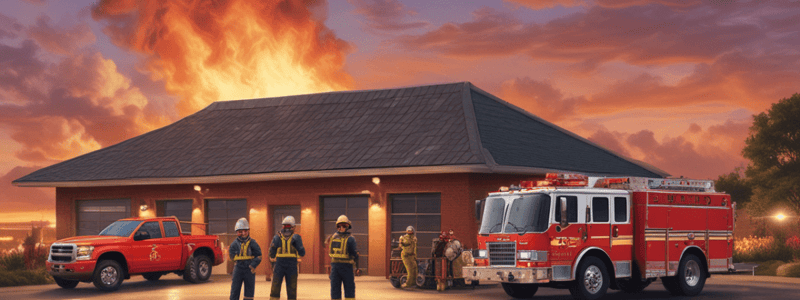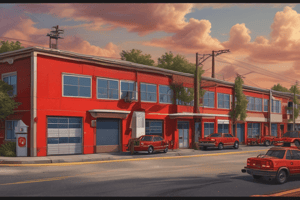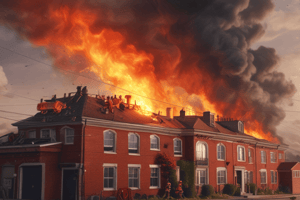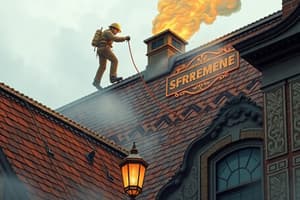Podcast
Questions and Answers
What must the first person reaching the roof do before attempting to work on it?
What must the first person reaching the roof do before attempting to work on it?
- Evaluate the ventilation plan
- Report to the Incident Commander
- Assess the fire conditions
- Quickly evaluate the structural soundness of the roof (correct)
Which of the following is NOT considered a stable platform for roof operations?
Which of the following is NOT considered a stable platform for roof operations?
- Aerial devices
- Roof ladders
- Portable radios (correct)
- Safety lines
When using roof ladders on metal roofs, what hazard must be evaluated?
When using roof ladders on metal roofs, what hazard must be evaluated?
- The weight capacity of the ladder
- The height of the roof
- The condition of the metal surface
- The slipping hazard from the ladder hooks (correct)
What is the primary objective during roof operations?
What is the primary objective during roof operations?
What must be reported to the Incident Commander regarding roof operations?
What must be reported to the Incident Commander regarding roof operations?
What does an Area of Safe Refuge on a roof indicate?
What does an Area of Safe Refuge on a roof indicate?
Which of the following is a requirement for personnel once they are on the roof?
Which of the following is a requirement for personnel once they are on the roof?
What is one of the key requirements regarding structural stability during roof operations?
What is one of the key requirements regarding structural stability during roof operations?
What is the minimum size for a vertical ventilation hole?
What is the minimum size for a vertical ventilation hole?
Which of the following should be understood by the company assigned to vertical ventilation?
Which of the following should be understood by the company assigned to vertical ventilation?
What is the recommended action regarding power saws during a vertical ventilation operation?
What is the recommended action regarding power saws during a vertical ventilation operation?
When performing vertical ventilation, it is advised that firefighters ____ while on the roof.
When performing vertical ventilation, it is advised that firefighters ____ while on the roof.
What is one of the purposes of utilizing roof ladders during vertical ventilation?
What is one of the purposes of utilizing roof ladders during vertical ventilation?
Which cutting method is appropriate for flat roofs during vertical ventilation?
Which cutting method is appropriate for flat roofs during vertical ventilation?
In terms of safety, what should be done before stepping on the roof?
In terms of safety, what should be done before stepping on the roof?
What is a recommended practice for extending the initial vertical ventilation hole?
What is a recommended practice for extending the initial vertical ventilation hole?
What is the primary purpose of the guidelines for roof operations?
What is the primary purpose of the guidelines for roof operations?
What criteria should the Incident Commander consider before committing personnel to roof operations?
What criteria should the Incident Commander consider before committing personnel to roof operations?
Which responsibility does the Assistant Safety Officer hold during roof operations?
Which responsibility does the Assistant Safety Officer hold during roof operations?
What is a recommended practice when accessing the roof during operations?
What is a recommended practice when accessing the roof during operations?
What should the Company responsible for roof operations ensure in terms of egress?
What should the Company responsible for roof operations ensure in terms of egress?
Which function does mechanical ventilation (PPV) serve in roof operations?
Which function does mechanical ventilation (PPV) serve in roof operations?
Which statement is true regarding the positioning of aerials during roof operations?
Which statement is true regarding the positioning of aerials during roof operations?
What is discouraged in roof operations regarding the number of personnel involved?
What is discouraged in roof operations regarding the number of personnel involved?
Flashcards
Aerials should be strategically positioned to allow
Aerials should be strategically positioned to allow
safe access to and egress from the roof. A tactical position that would permit effective defensive operations if needed.
Incident Commander Responsibilities
Incident Commander Responsibilities
a. The Incident Commander should evaluate and determine the need to establish roof operations. Roof stability must be considered before committing personnel to it.
The Incident Commander should consider:
The Incident Commander should consider:
i. Assigning an Assistant Safety Officer to observe roof conditions. ii. Using the Aerial apparatus and personnel for roof operations. iii. Using mechanical ventilation (PPV) as an aid to vertical ventilation
Aerial Positioning
Aerial Positioning
Signup and view all the flashcards
Minimizing Personnel
Minimizing Personnel
Signup and view all the flashcards
Incident Commander Role
Incident Commander Role
Signup and view all the flashcards
Assistant Safety Officer Responsibilities
Assistant Safety Officer Responsibilities
Signup and view all the flashcards
Company responsibilities
a. A Company assigned to roof operations shall:
Company responsibilities a. A Company assigned to roof operations shall:
Signup and view all the flashcards
A stable platform includes, any of the following:
A stable platform includes, any of the following:
Signup and view all the flashcards
An Area of Safe Refuge on an
An Area of Safe Refuge on an
Signup and view all the flashcards
The first person reaching the roof must quickly
The first person reaching the roof must quickly
Signup and view all the flashcards
Once on the roof, personnel must evaluate
Once on the roof, personnel must evaluate
Signup and view all the flashcards
Roof ladders used on metal roofs pose a
Roof ladders used on metal roofs pose a
Signup and view all the flashcards
A constant re-evaluation must be performed
A constant re-evaluation must be performed
Signup and view all the flashcards
Vertical Ventilation
Vertical Ventilation
Signup and view all the flashcards
Roof ladders:
Roof ladders:
Signup and view all the flashcards
Operating Power Saws
Operating Power Saws
Signup and view all the flashcards
Ventilation Hole Size
Ventilation Hole Size
Signup and view all the flashcards
Extending Ventilation Holes
Extending Ventilation Holes
Signup and view all the flashcards
The Company assigned to roof operations must make note of (and report to the Incident Commander) the following, if applicable:
The Company assigned to roof operations must make note of (and report to the Incident Commander) the following, if applicable:
Signup and view all the flashcards
The Company assigned to vertical ventilation should:
The Company assigned to vertical ventilation should:
Signup and view all the flashcards
Personnel Accountability Reports
Personnel Accountability Reports
Signup and view all the flashcards
Sounding the Roof
Sounding the Roof
Signup and view all the flashcards
The Company assigned to vertical ventilation should: viii. Carry the following equipment, as a minimum:
The Company assigned to vertical ventilation should: viii. Carry the following equipment, as a minimum:
Signup and view all the flashcards
The objectives for roof operations include:
The objectives for roof operations include:
Signup and view all the flashcards
Depending on roof type and degree of ease or difficulty of the operation, firefighters need to decide which cut to select when making a vertical ventilation hole. Examples include:
Depending on roof type and degree of ease or difficulty of the operation, firefighters need to decide which cut to select when making a vertical ventilation hole. Examples include:
Signup and view all the flashcards
The vertical ventilation hole must be at least
The vertical ventilation hole must be at least
Signup and view all the flashcards
Utilize natural openings such as
Utilize natural openings such as
Signup and view all the flashcards
Utilize any of the following to ascertain the presence of fire:
Utilize any of the following to ascertain the presence of fire:
Signup and view all the flashcards
Study Notes
Purpose and Authority
- Provides guidelines for safe operations on a roof during firefighting incidents.
- Authority is vested in the Fire Rescue Administrator.
Scope
- Applies to all Emergency Operations personnel engaged in roof operations.
General Information
- Aerials should be positioned for safe roof access and potential defensive operations.
- Minimize personnel on the roof to only those necessary for the task.
Incident Commander Responsibilities
- Evaluate roof stability before personnel commit to operations.
- Consider assigning an Assistant Safety Officer and utilizing aerial apparatus for operations.
- Use mechanical ventilation as an aid to vertical ventilation only when appropriate.
Assistant Safety Officer Responsibilities
- Observe roof operations from a safe distance (e.g., aerial ladder or adjacent building).
Company Responsibilities
- Access roofs from stable platforms.
- Ensure at least two means of egress.
- Personnel must wear full PPE including SCBA and carry portable radios.
- Use a roof ladder and tools to assess roof conditions.
- First personnel must quickly evaluate roof stability upon arrival.
- Constantly reassess conditions during operations to ensure safety.
Roof Ladder Use
- Be aware of slipping hazards on metal roofs when using roof ladders.
- Report roof design, structural conditions, fire impact, fire walls, natural openings, heavy objects, and ventilation needs to the Incident Commander.
Objectives for Roof Operations
- Continuously evaluate roof stability.
- Conduct adequate vertical ventilation.
- Provide progress updates to the Incident Commander.
- Ensure all personnel vacate the roof after operations.
Vertical Ventilation
- Conduct vertical ventilation only when fire location is known and roof is safe.
- May require team efforts due to equipment needs.
- Roof ladders assist in weight distribution and emergency escape.
- All power saws must be started on the ground; do not run saws while climbing or hoisting.
Ventilation Hole Details
- Minimum size of ventilation hole should be 16 square feet (4’ x 4’), ideally located over the fire.
- Consider extending ventilation holes when necessary.
Company Assigned to Vertical Ventilation
- Must understand roof structure and coverings.
- Plan cuts efficiently to reduce time spent on the roof.
- Maintain Personnel Accountability Reports (PAR) on and off the roof.
- Sound the roof before and during operations.
- Carry essential equipment: appropriate saws, axe, etc.
Studying That Suits You
Use AI to generate personalized quizzes and flashcards to suit your learning preferences.




